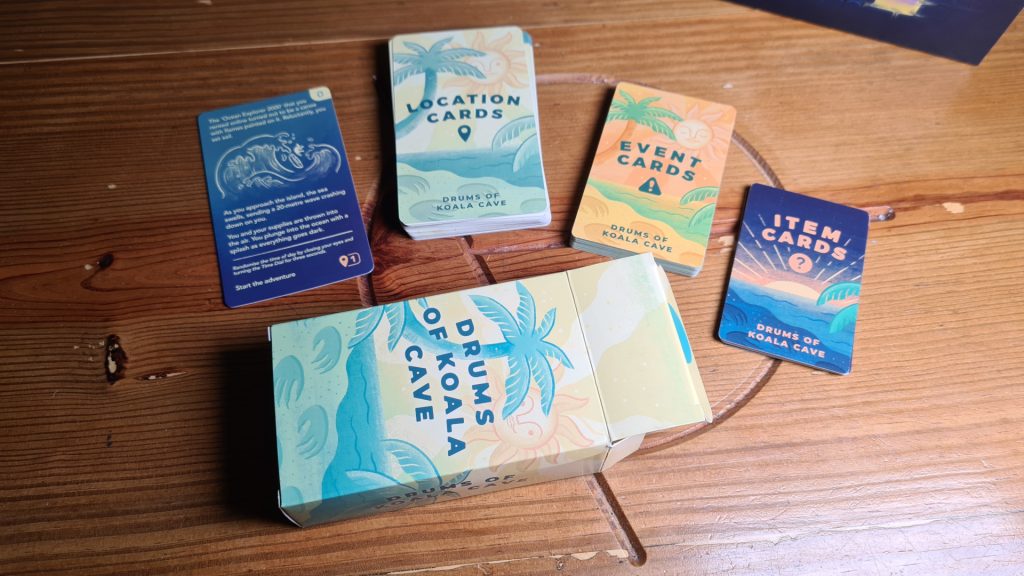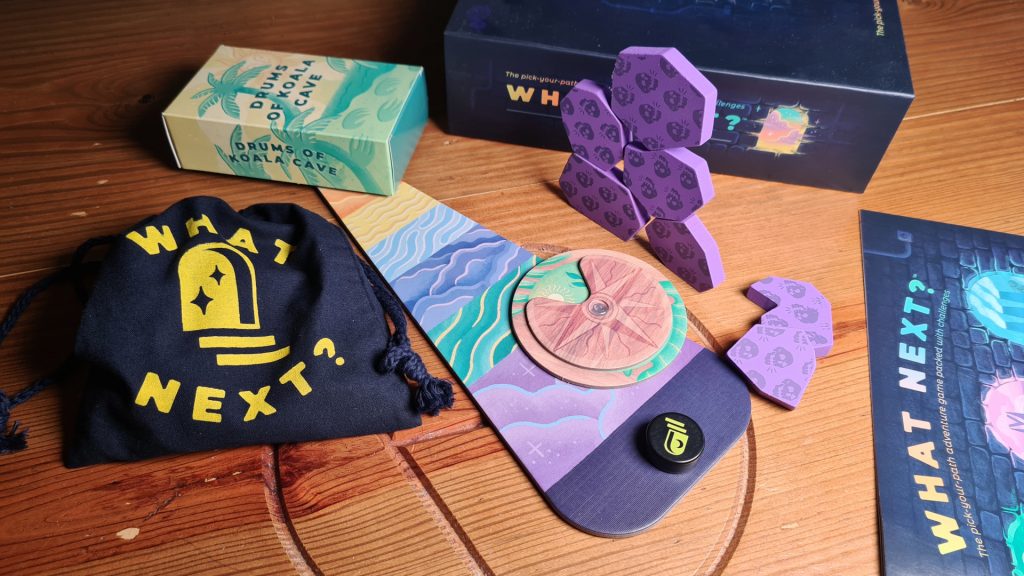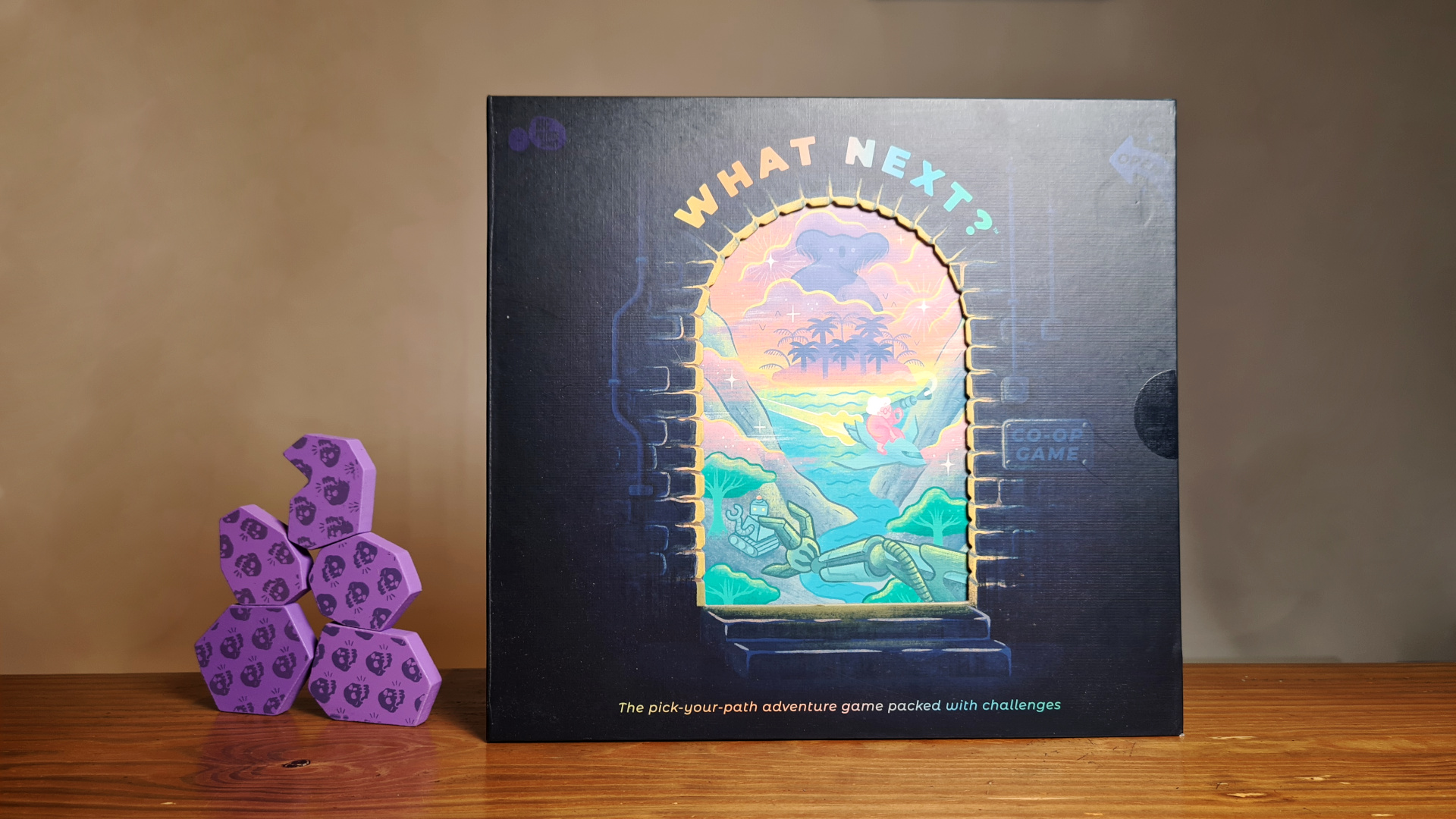What Next? is the brand new cooperative, choose your own adventure style, board game from Big Potato Games. Designed by Ed Naujokas, featuring artwork from Beks Barnett and Zoe Lee, the game sees 1 – 4 players coming face to face with gigantic koalas, robots and… an old lady. Big Potato Games are often known for their party games, and this isn’t just a narrative experience with choices along the way. Sprinkled in throughout the three included adventures are a range of dexterity based challenges to overcome. However, are these adventures you’ll want to go on? Let’s find out!
Players start by choosing an adventure; Koala Cave, The Skyscraper Caper or Blinky’s Great Escape. Retrieving the adventure box from the game box, players can either read the introduction in the rulebook or have it read to them via scanning a QR code. This sets the scene, giving a little background, before setting players free into the adventure.
The adventure boxes contain location, event and item cards – which players should not shuffle or look through ahead of time. The time dial associated with the adventure and all of the challenge items are also taken from the box. For added fun, during the first playthrough, you can leave the challenge pieces in the box and only pull them out when challenges require them – to keep the others around the table in the dark.
As instructed by the adventure intro, players start with card 0 of the current adventure’s location deck. Locations drive the plot forward. Reading aloud the flavour text, locations will tell the players what is found at the location, accompanied by an illustration. They then commonly present the group of players with a choice. This may be between venturing to one of two locations, or perhaps doing an event at the current location before moving on.

If proceeding to a new location the time dial is rotated onwards, with the new card revealed from the location deck. When the time dial reaches night time then the reverse side of the location card is used, and there’s much more peril at night. If performing an event the team takes the event card numbered from the deck. This will reveal if it is a challenge involving flicking, item search, building or one of many one off challenges. Tasks are either against the clock, so someone will need their phone out for a timer, or offer the player a number of practices before one real attempt.
If the nominated player succeeds the team may be rewarded with an item from the item deck, which may help them later on. Instead, this could see them advance to a different location or simply avoid peril. Failing an event isn’t necessarily game over and nor is receiving peril. Peril however could cause the team’s downfall. When peril is received the team must start or add to a peril tower. This is a balanced tower of non-uniformly shaped blocks – which has only two blocks touching the table. The team must advance through the adventure, avoiding or balancing peril. If they manage to complete the adventure before the peril tower falls the team wins, though if at any time the peril tower falls it’s all been too much for them and the team loses.
Having the peril tower slowly but surely building up really drives the tension and pressure on the team. It’s there as a constant reminder of how well / badly you’re doing and could fall if the table takes too much of a nudge. It is potentially a bit difficult for families to get through the experience. To get around this the team could decide to have a bonus life or two to lose when taking peril, before starting to build the tower. It’s not in the rules but this could help some groups experience the full adventure rather than crashing out half way through each time.
After a few plays the story decisions of an individual adventure do become known – at least those in the early sections. It may take the team a few attempts to get through each adventure and this means it can feel a bit like speeding through, skipping the flavour text, and just performing the events as they arise in the later plays. Though, this only opens the door for players to learn the cleanest way through an adventure.

The events aren’t constantly hurled at players but nor are they too sparsely dotted along the journeys. Every few new locations players will be diving into a bag or flicking the puck for one reason or another. This enables the choose your own adventure story to present choices and not leave everything to the outcome of a challenge.
The challenges are what makes What Next? thrive. They add the dexterity difficulties that allow players to attempt things and fail. Rather than just stumbling through a plot, players cheer and groan due to the outcomes, though hopefully without nudging the table and toppling the peril tower. Thematically the challenges are a mixed bag, some matching the idea of searching around or fixing something, while others are more abstract representations. Regardless, the challenges are what keep players wanting to play again. One or two more in the stories would have been nice but a good balance was struck. Enabling the group to attempt things and see if the majority passed may have kept everyone that bit more invested though.
What Next? includes the three stories to play through, each with decks of locations, events and items. The artwork that adorns the cards adds that visual touch to everything players come across, with intuitive symbols to let players know which deck to draw from. The components that are used for the challenges though take the production quality to the next level. Thick chunky peril pieces (which are always just the wrong shape to easily balance), a logoed drawstring bag for the plastic search shapes and even the plastic puck and solid cardboard flick board are all designed to last many, many plays.
What Next? offers a rather unique twist on regular choose your own adventure style experiences. The quirky stories are fun to play through and let unfold, though it is the mixture of narrative choices with getting hands on with the physical dexterity challenges that gets players involved and immersed. The surprises of the story do ebb away with repeat plays, though the determination to complete them does drive players to return, plus there are three unique adventures included. The combination of story and dexterity isn’t just a gimmick, it is this mix that means the game is fun, play after play. Hopefully, this is successful for Big Potato Games as I’d love to see more adventures in this series!
(Editor’s Note: What Next? was provided to us by Big Potato Games for the review.)

